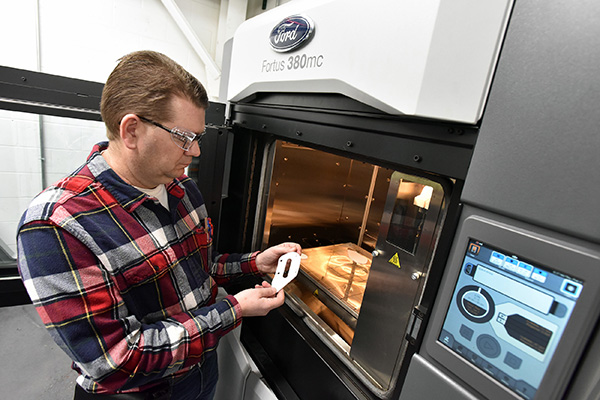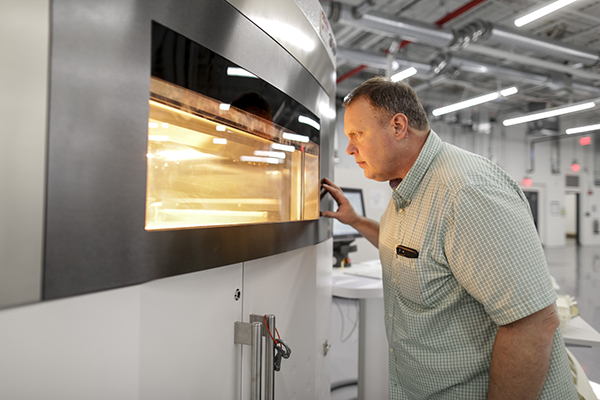CAASE20: AM-Focused Tracks and Talks in Upcoming Simulation Conference
Virtual simulation conference lineup includes trends and practices in 3D printing

Wayne McKinney of Ford’s Kentucky Truck Plant checks a part that was just printed using a 3D printer. The use of 3D printing in automotive is part of upcoming CAASE20 Virtual Conference coverage. Image courtesy of Ford.
Latest News
May 18, 2020
The upcoming CAASE20 Virtual Conference (June 16-18), cohosted by DE, features a robust lineup of talks and presentations focused on AM (additive manufacturing) or 3D printing. Topics range from the use of AM in automotive, part optimization, product lightweighting, assembly consolidation, and materials info to lattice design.
Here are some details on the sessions, based on the presenters’ abstracts submitted and accepted. (Please note that conference content may change.)

Stronger Lighter Automotive Parts
In “Additive Manufacturing Applied in Cost & Weight Reduction Strategies in Automotive Components,” Christian Castro, Ford Motor Company, is set to discuss “the 'plasticization' of components that were previously made of steel, aluminum or different alloys,” driven by the desire to reduce weight. The trend opens the possibility to explore “new geometries by means of topological and topographic optimizations but also to establish the bases that would allow these components to be manufactured by 3D printing methods,” he says.
In “Influence Of Support Material Design In Additive Manufacturing For Strength Performance,” Kristian Flores, Ford Motor Company, plans to show “the sensitivity of different parameters that define the support structures generation for additive manufacturing to design smarter supports to improve the component’s strength performance.”
He points out, “The creation of support structures in additive manufacturing is a very critical task, which depends on the experience of each engineer, therefore if it is not done correctly, it could cause problems such as collapse, shift and imbalance of the part.”
In “Generative Design When It Matters Most,” Praveen Yadav, SciArt Software, establishes the common link in weight reduction, material optimization, FEA Optimization, and AM. “Topology optimization directly caters to 3D printing because the output from topology optimization is typically an STL file, that can be directly 3D printed, and for most 3D printing processes (especially, metal 3D printing), material reduction is critical,” he notes.
In “Virtual Design, Validation, and Manufacturability for Metal Powder-Bed AM,” Robert Hoglund, Altair Engineering, shows how simulation in an integrated environment can accelerate product development for laser powder-bed fusion AM.
The presenter studies the design of a part, beginning with the original CAD model, followed by topology optimization and validation of geometry, and the proper orientation and support structure. Finally, he conducts thermomechanical simulation of the AM process to predict build defects and issues in the same environment and give feedback to the product designer.
Tackling Lattice Models and RF Devices
In “Prediction of Microstructure within Additively Manufactured Parts through the Use of Finite Element Methods and Cellular Automata,” Madie Allen from TWI introduces a way to predict microstructure for metal AM.
Allen explains, “we must first be able to understand the links between process parameters, microstructure and resultant properties through the use of integrated computational materials engineering (ICME) … The ultimate goal of this work is to contribute towards an extensive modelling method that allows for process optimization and design for metal AM parts, enabling microstructure tailoring and control.”
In “Structural Optimization of FRep Models and Their Additive Manufacturing,” Dmitry Popov, Skolkovo Institute of Science and Technology, discusses ways to perform structural optimization suitable for AM using function representation (FRep) of the geometry.
“FRep provides an ability to freely parametrize a model ... This representation guarantees the correctness of a shape for meaningful parameters,” he explains.” The presentation covers several techniques for lattice modeling and hole nucleation.
In “Assembly Consolidation in Additively Manufactured Waveguides,” Laila Salman, ANSYS Canada, discusses using simulation techniques to optimize their RF (radio frequency) designs for AM production. Her presentation “illustrates the use of multiphysics simulation techniques in the design and optimization of an RF waveguide assembly that integrates three RF functionalities including bending, twisting and filtering sections operating in Ku/K‐Band.”
CAASE20 Conference is free to NAFEMS members. To register, go to www.nafems.org/events/nafems/2020/caase20/
Subscribe to our FREE magazine, FREE email newsletters or both!
Latest News
About the Author
Kenneth Wong is Digital Engineering’s resident blogger and senior editor. Email him at kennethwong@digitaleng.news or share your thoughts on this article at digitaleng.news/facebook.
Follow DE





